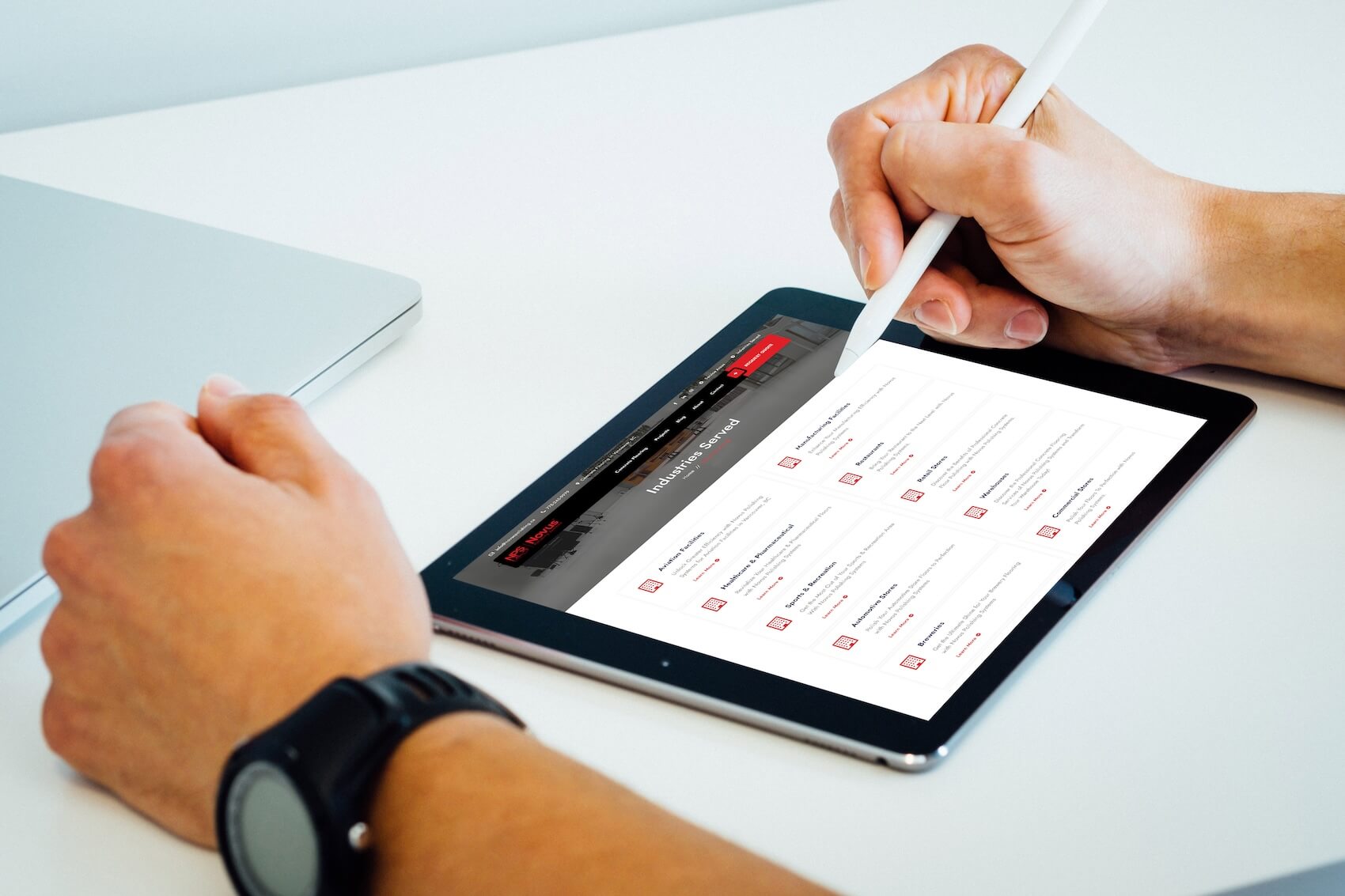For many small business owners, your website serves as the digital storefront to your business, often providing the first impression to potential customers.
Just as you wouldn't want a cluttered, out-of-date physical storefront, your digital presence should mirror the professionalism, currentness, and branding that reflect your business's values and mission. Unfortunately, an outdated or poorly functioning website could be turning potential customers away without your knowledge.
Understanding when to invest in a website redesign is paramount to maintaining a competitive edge in the digital landscape. Here are the five warning signs your small business website may need a revitalizing facelift.
Sign 1: Outdated Design
Your website might be the first thing a potential customer sees, and an outdated design can immediately give off the wrong impression. “A website looking like it's from a bygone era sends a message that your business is not keeping up with industry trends or consumer expectations,” states Ivan Dancourt, Marketing Director at Solocube Creative. Modern websites prioritize ease of navigation with clean, minimalistic designs that focus on user experience. An outdated website could result in a higher bounce rate and fewer conversions.
- Check for Mobile Responsiveness: With the increasing usage of smartphones, your website must perform seamlessly across devices. An outdated design often lacks mobile responsiveness, which can frustrate users and lead them to leave your site.
- Look at Your Competitors: Compare your website's design to those of your leading competitors. If yours feels behind in terms of layout, aesthetics, or functionality, it's a sign that you need an update.
- Evaluate Your Content Layout: Modern websites favor clean, minimalist designs that make content easy to read and interact with. If your site has cluttered pages, excessive text without clear headings, or difficult navigation, its design is likely outdated.
- Assess the Use of Multimedia: Outdated websites often underutilize multimedia elements or use them in ways that feel unpolished. Current design trends incorporate high-quality images, videos, and infographics that enhance user engagement.
- Analyze Loading Times: Older website designs may not be optimized for speed, resulting in longer loading times. Visitors expect fast loading pages; delays can drive them away.
- Check for Social Media Integration: If your website lacks easy-to-use social media sharing buttons or links to your social media profiles, it's missing out on a key aspect of modern web design.

Sign 2: Poor Mobile Responsiveness
With more people now using their smartphones to browse the internet than ever before, having a mobile-responsive website is not an option—it's a necessity. Ivan Dancourt mentions, “A website that doesn't adjust to fit the screen of a tablet or smartphone is potentially missing out on a vast audience.” Mobile responsiveness impacts not only the user experience but also search engine rankings, making it a crucial aspect of your digital presence.
- Use Responsive Design Checkers: Utilize online tools and websites that allow you to enter your website's URL to see how it displays on different screen sizes and devices. This can give you a quick overview of any glaring issues with mobile responsiveness.
- Manual Testing with Actual Devices: Nothing beats the accuracy of manually testing your website on various smartphones and tablets. This process involves physically navigating your site on different devices to check for issues with layout, navigation, and touch responsiveness.
- Browser Developer Tools: Most modern web browsers, such as Chrome, Firefox, and Safari, have built-in developer tools. These can simulate how your website looks and functions on different mobile devices, allowing you to pinpoint specific areas that need improvement.
- Google's Mobile-Friendly Test: Google offers a free tool that analyzes a webpage and reports if it has a mobile-friendly design. Besides identifying issues, it provides suggestions for improvement, which can be invaluable for enhancing user experience.
- Check Loading Times: Mobile users expect quick loading times. Tools like Google PageSpeed Insights will not only evaluate your site's loading speed on both desktop and mobile devices but also suggest optimizations to improve performance.

Sign 3: Slow Loading Speed
In an era where speed is everything, a website that takes too long to load is a sure sign that a redesign is in order. Page load times directly affect user retention; studies have shown that users are likely to abandon a site if it doesn't load within a couple of seconds. “Search engines punish slow loading speeds and can hurt your visibility,” adds Ivan Dancourt. Optimizing images, leveraging browser caching, and reducing server response time are key factors in increasing page speed.
Given the importance of quick loading times for both user experience and search engine optimization, it's critical to understand where and how you can check your website's page speed.
A popular tool for this purpose is Google's PageSpeed Insights. This free service analyzes the content of a web page, then generates suggestions to make that page faster. By simply entering your website's URL, you can receive a detailed report of your site's performance on both mobile and desktop devices, along with specific recommendations for improvement. Regularly monitoring your website's speed with tools like PageSpeed Insights can help ensure you're providing a swift and seamless experience for your visitors.

Sign 4: Low Conversion Rates
If you're seeing traffic to your website but aren't noticing an equivalent level of engagement or sales, your site might not be optimized for conversion. “Design plays a critical role in guiding users toward the action you want them to take,” explains Dancourt. A website redesign focused on conversion rate optimization can help turn visitors into customers by simplifying form fields, adding clear call-to-actions (CTAs), and creating an intuitive user flow.
Understanding Low Conversion Rates on Your Website
Low conversion rates on a website signify a disconnection between the site content and what visitors are willing to commit to—be it making a purchase, signing up for a newsletter, or filling out a contact form. Here are some bullet points expanding on what this implies:
- Lack of Targeted Content: Your website might not be providing the specific information or solutions sought by your audience. Content that fails to address the needs or interests of your visitors can lead to high bounce rates and low conversions.
- Poor User Experience (UX): Navigational difficulties, confusing layout, or an overwhelming amount of information can frustrate users. A seamless user experience is key to guiding visitors to conversion points smoothly.
- Ineffective Call-to-Actions (CTAs): CTAs that are not compelling or are hard to find can significantly reduce conversion rates. Each page should have clear and persuasive CTAs that guide users towards the next step.
- Trust Issues: Lack of trust signals such as secure payment icons, privacy assurances, and genuine customer testimonials can make visitors hesitant to take the final step.
- Not Mobile-Friendly: With the increasing use of smartphones for internet browsing, a site that is not optimized for mobile can alienate a large portion of potential customers, affecting conversions negatively.
Addressing these factors through a carefully planned website redesign can enhance the alignment between site content and user expectations, ultimately improving conversion rates.

Sign 5: High Bounce Rates
A high bounce rate, where visitors leave your site after viewing just one page, can indicate that your site is not providing the value or experience users are seeking. “This could be a result of confusing navigation, lack of compelling content, or simply that the website is not meeting user expectations,” Ivan Dancourt notes. Analyzing the reasons behind a high bounce rate can provide insights into areas of your website that need improvement.
To determine if your website is experiencing high bounce rates, you can utilize several methods and tools:
- Google Analytics: This is the most common tool used to measure bounce rate. By setting up Google Analytics on your website, you can track various metrics, including bounce rate, which indicates the percentage of visitors who leave your site after viewing only one page.
- Heatmap Tools: Tools like Hotjar or Crazy Egg provide heatmap services that allow you to visually understand how users interact with your site. Areas of your site that are ignored may contribute to higher bounce rates.
- Exit Survey Pop-ups: Implementing exit survey pop-ups can help you understand why users are leaving your site without interacting further. This direct feedback can pinpoint issues leading to high bounce rates.
- Benchmarking: Compare your site’s bounce rate with industry benchmarks. A significantly higher bounce rate than the average could indicate an issue.
- Session Replay Tools: These tools allow you to see how users interact with your site in real-time, providing insights into why they might leave quickly.
- Mobile Responsiveness Test: Test your website’s mobile responsiveness, as poor mobile experiences can significantly contribute to high bounce rates.
Understanding and analyzing your website's bounce rates through these methods can provide valuable insights, allowing you to make the necessary adjustments to enhance user engagement and reduce bounce rates.
Conclusion
Recognizing the signs that your website needs a redesign can save you from losing potential customers due to a poor digital experience. An updated, well-designed website is crucial for any small business looking to stand out in today’s competitive online marketplace. If your site falls into any of the categories mentioned above, it might be time to consider a redesign.
Ready to take the first step towards achieving a cutting-edge, conversion-optimized website? Don't hesitate to reach out to SoloCube Creative for a complimentary website redesign consultation. With our expertise, we'll ensure your website not only looks appealing but also performs excellently across all key metrics. Contact us now to begin the transformation your online presence deserves.







